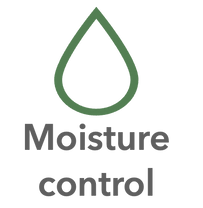
HUMIDITY CONTROL
Improve ventilation. Air circulation. Comfort for employees. Reduce energy costs.

1. Preventing Condensation:
In facilities with temperature differentials, such as cold storage warehouses or manufacturing plants, condensation can be a problem. HVLS fans help prevent condensation by mixing the air layers, ensuring that warm air from heating systems is evenly distributed and doesn't come into contact with cold surfaces.
2. Even Humidity Distribution:
HVLS fans can help maintain consistent humidity levels by distributing moisture evenly throughout the space. This is particularly important in industries like food processing and textiles, where humidity control is essential for product quality.
3. Reducing Stagnant Air:
Stagnant air can contribute to moisture buildup and the growth of mold and mildew. HVLS fans keep the air moving, preventing pockets of stagnant, humid air from forming in hard-to-reach areas.
4. Ventilation and Moisture Removal:
In facilities where humidity levels can rise significantly, such as in greenhouses or indoor agricultural operations, HVLS fans can aid in the ventilation process. They can help remove excess moisture from the air by promoting airflow and encouraging evaporation.
5. Moisture Dispersal:
HVLS fans can disperse moisture and humidity generated by processes or equipment. For example, in manufacturing processes that generate steam or moisture, HVLS fans can help distribute this moisture evenly throughout the facility, preventing localized high humidity areas.
6. Preventing Corrosion:
In settings where corrosion is a concern, such as metalworking facilities or marine environments, controlling humidity is crucial. HVLS fans can help reduce the risk of corrosion by preventing moisture from collecting on equipment and surfaces.

8. Enhancing Drying Processes:
In industries like ceramics or paper production, where drying processes are integral, HVLS fans can aid in the drying of materials by promoting the evaporation of moisture.
7. Reducing Mold and Mildew Growth:
Improved air circulation provided by HVLS fans can reduce the conditions favorable for mold and mildew growth. This is important in facilities where sanitation and product quality are critical, such as food processing plants.
10. Temperature Regulation:
By maintaining consistent temperatures and preventing temperature fluctuations, HVLS fans can indirectly contribute to moisture control. Lowering the relative humidity in a space can make it less conducive to moisture-related issues.
9. Customized Airflow:
HVLS fans can be strategically positioned and controlled to focus airflow where moisture control is most critical. This allows for targeted solutions in areas prone to moisture-related problems.
Properly designed and installed HVLS fan systems, along with other moisture control measures like dehumidifiers and insulation, can help industrial facilities maintain optimal humidity levels, prevent moisture-related problems, and ensure product quality and employee comfort.






